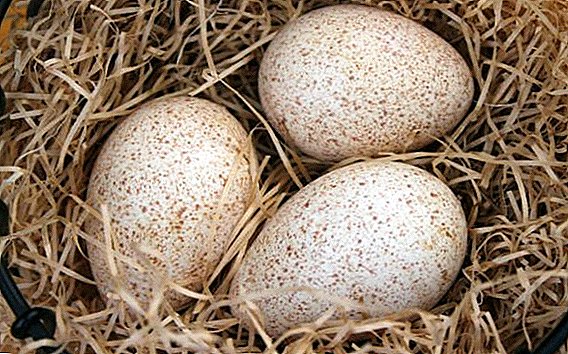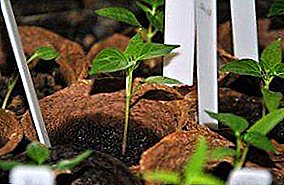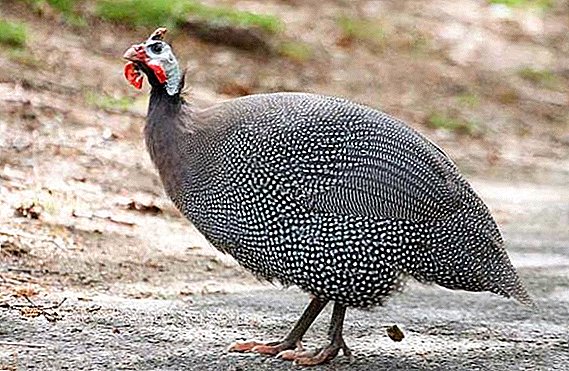 Guinea fowl are poultry known in farming circles for their productive qualities and unpretentious temper. However, like other inhabitants of household yards, they can get sick and die. To prevent this, it is necessary to study the symptoms of possible illnesses, as well as methods for their prevention and treatment.
Guinea fowl are poultry known in farming circles for their productive qualities and unpretentious temper. However, like other inhabitants of household yards, they can get sick and die. To prevent this, it is necessary to study the symptoms of possible illnesses, as well as methods for their prevention and treatment.
Causes of disease
Despite a fairly strong immune system, infectious diseases in flocks of guinea fowls spread almost immediately.  The causes of diseases lie in inadequate unhygienic conditions, poor diet, as well as in contacts with wild or domestic birds - carriers of infections that live next door.
The causes of diseases lie in inadequate unhygienic conditions, poor diet, as well as in contacts with wild or domestic birds - carriers of infections that live next door.
Did you know? In the world there are only 7 species of birds from the genes of guinea fowls. Being feathered, they live in large groups of 20-30 individuals. They take off extremely rarely and move at a leisurely pace, which in the event of danger can turn into a fairly fast run.
Types of diseases
Some types of diseases are not considered particularly dangerous, and some can lead to imminent death of livestock. One way or another, the ailments should be diagnosed in a timely manner, after which the medical measures prescribed by the veterinarian can be quickly organized.
Infectious diseases
Diseases caused by microorganisms are characterized by a rapid spread and a pronounced clinical picture. 
Trichomoniasis
The causative agent of the disease, Trichomonas microbe, as a rule, enters the guinea fowl through the poor quality food or a dirty source of drinking.
Its occurrence is accompanied by the following symptoms:
- frothy diarrhea;
- intense thirst;
- lethargy, lowered wings;
- yellow mucous membranes;
- labored breathing;
- oxygen starvation;
- exhaustion.
Important! The treatment of guinea fowl can not engage in their own, as well as give them any medications. Necessary medications and measures can only be prescribed by a veterinarian, after diagnosis and analysis of the condition of diseased birds.
Treatment methods for trichomoniasis:
- feeders and drinkers are washed with hot water and baking soda;
- clean water in the drinkers changes every morning;
- At the initial stage of the disease, treatment with Cardinosol ("Ipronidazole") is possible.

Pasteurellosis
Pasteurella bacteria most often infect juveniles.
With characteristic symptoms, birds are removed from the flock and eliminated, since the disease is infectious and incurable:
- lethargy, limited movement;
- temperature rise;
- diarrhea of various shades with a touch of ichor: yellow, gray, green;
- accumulation and secretion of mucus from the beak.
At the onset of the acute form of pasteurellosis, the guinea fowl die within three days. Meat of sick birds cannot be eaten categorically, therefore their carcass must be disposed of as soon as possible.
Check out the list of wild and domestic breeds of guinea fowls, how to properly breed guinea fowls, as well as learn about the peculiarities of the content of guinea fowl and guinea fowl of the Zagorskaya white-breast.
Pullorosis
Pullorosis, in other words - bacillary white diarrhea, is accompanied by:
- total immobility;
- loss of coordination;
- white shade of litter.
 The chronic form of the disease in young animals suggests a slower pace of development, in adults - exhaustion, and in some cases peritonitis.
The chronic form of the disease in young animals suggests a slower pace of development, in adults - exhaustion, and in some cases peritonitis.Unfortunately, infected birds can not be cured - they must be eliminated. The rest of the livestock in the pack is treated with a broad-spectrum antibiotic prescribed by a doctor.
Invasive
Invasion (the infestation of the avian organism by parasites) cannot be detected independently - known helminth subspecies are determined only in the veterinary laboratory, and some of the symptoms inherent in the lesion are similar to other infectious diseases:
- growth retardation;
- sharp loss of muscle mass;
- various problems with the gastrointestinal tract.
Important! Infection with fleas and perojes is not fatal for birds, but it brings to birds and their owners a lot of unpleasant problems: the plumage spoils, affects the quality of meat and the ability to carry eggs. To get rid of obsessive parasites most often use natural herbal methods: chamomile, tansy and wild rosemary infusions.
Treatment for invasions is carried out by antihelminthic drugs, in especially severe cases, the birds are killed. 
Non-contagious
Diseases of non-infectious origin (non-infectious) occur in guinea fowls, as a rule, due to mistakes made in the diet or in the arrangement of accommodation:
- reduced amount or absence of greens, grain variety, mineral additives in the menu;
- cold drafts and dampness in the house.
It will also be useful for you to learn how to breed guinea fowl in a home incubator, how to care for guinea fowl chickens, how to properly contain guinea fowls in winter.
Dyspepsia
Dyspepsia - damage to the digestive system. The risk group includes young guinea fowls, whose nutrition consists of poor quality and unbalanced raw materials, as a result of which the birds' stomach does not normally digest food.
The main symptoms of dyspepsia:
- frothy diarrhea mixed with mucus;
- poor appetite;
- decrease in motor activity.
 After delivery of the diagnosis, the following method of treatment is prescribed: sealing off diseased individuals with a 0.2% solution of copper sulfate or 0.3% solution of baking soda in water.
After delivery of the diagnosis, the following method of treatment is prescribed: sealing off diseased individuals with a 0.2% solution of copper sulfate or 0.3% solution of baking soda in water.Rhinitis
Impaired temperature and increased humidity in the room are often accompanied by rhinitis (runny nose) in guinea fowls of all ages.
Symptoms:
- copious mucous discharge from the beak;
- poor appetite;
- labored breathing.
To stop the disease, antibacterial drugs are used, which are diluted with clean water and instilled into the beak nostrils. 
Omphalite
Omphalitis is a severe pathological condition in which the umbilical ring in newborn chicks does not grow to the end.
Soon the inflammatory process begins in the wound, which is accompanied by the following symptoms:
- low activity;
- seat with the head down;
- an increase in the abdomen;
- suppuration.
Find out how useful and how calorie guinea fowl meat.
The cause of the disease is the wrong temperature during the incubation of eggs. With timely measures, the chicks can fully recover.
The treatment involves: deposition of the weakened young in a separate enclosure, feeding the feed with additional vitamin and mineral supplements, as well as unsoldering with the prescribed antibacterial drugs. The umbilical wound is preferably treated with a special healing ointment. 
Why guinea fowl fall to their feet
The reasons for the fall of guinea fowl on the legs can be varied:
- salt deposition in the joints;
- growths on the legs, gout;
- uniform, poor feeding;
- food treated with chemicals that destroy insects.
In addition to falling to their feet, other, more serious symptoms may also occur in birds:
- decrease in motor activity;
- joint thickening;
- loss of appetite, exhaustion.
Ignoring the symptoms can lead to the death of the bird, so when any manifestations are detected, you should begin a comprehensive treatment:
- Smear the affected leg joints with iodine or salicylic ointment;
- Add 10 g of bicarbonate soda to the drinker with water (repeat for two weeks);
- Enrich the diet with green, vitamin feed;
- To organize guinea fowls active walking in a spacious, clean area.

Preventive measures
As you know, to prevent any disease in the inhabitants of the poultry yard is possible only with the help of competently organized prevention.
The process should go in several directions:
- The room in which the guinea fowls live should be spacious and kept clean. Drinkers and feeders should be regularly disinfected.
- An important role is played by a properly formulated, balanced diet. Water should be clean, and feeding should be done at certain hours.
- Conducting timely isolation of sick chickens.
- Livestock vaccination according to age and veterinary requirements.
 Now you know how to take care of the health of guinea fowls.
Now you know how to take care of the health of guinea fowls.Did you know? The presence of guinea fowls on any farm can be determined at a distance. The thing is a heart-rending loud scream, which they use together in the event of a cat, dog or stranger approaching. Sometimes the cry of one of the birds is a message that it dominates the whole flock.
Ensuring that these birds have proper housing conditions will not only help to prevent many unpleasant diseases, but will also ultimately provide high-quality, environmentally friendly meat and nutritious eggs.












